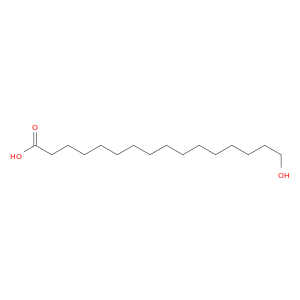
16-Hydroxyhexadecanoic acid
| Title | Journal |
|---|---|
| Authentication of beeswax (Apis mellifera) by high-temperature gas chromatography and chemometric analysis. | Food chemistry 20130115 |
| Identification of O-mannosylated virulence factors in Ustilago maydis. | PLoS pathogens 20120301 |
| Septation of infectious hyphae is critical for appressoria formation and virulence in the smut fungus Ustilago maydis. | PLoS pathogens 20110501 |
| Self-assembly, foaming, and emulsifying properties of sodium alkyl carboxylate/guanidine hydrochloride aqueous mixtures. | Langmuir : the ACS journal of surfaces and colloids 20110419 |
| Etiological analysis of neurodevelopmental disabilities: single-center eight-year clinical experience in south China. | Journal of biomedicine & biotechnology 20110101 |
| Defective in cuticular ridges (DCR) of Arabidopsis thaliana, a gene associated with surface cutin formation, encodes a soluble diacylglycerol acyltransferase. | The Journal of biological chemistry 20101203 |
| Abscisic acid deficiency causes changes in cuticle permeability and pectin composition that influence tomato resistance to Botrytis cinerea. | Plant physiology 20101001 |
| LAP5 and LAP6 encode anther-specific proteins with similarity to chalcone synthase essential for pollen exine development in Arabidopsis. | Plant physiology 20100701 |
| Sho1 and Msb2-related proteins regulate appressorium development in the smut fungus Ustilago maydis. | The Plant cell 20100601 |
| Nonhost resistance of barley to different fungal pathogens is associated with largely distinct, quantitative transcriptional responses. | Plant physiology 20100401 |
| Cytochrome P450 family member CYP704B2 catalyzes the {omega}-hydroxylation of fatty acids and is required for anther cutin biosynthesis and pollen exine formation in rice. | The Plant cell 20100101 |
| Burkholderia thailandensis harbors two identical rhl gene clusters responsible for the biosynthesis of rhamnolipids. | BMC microbiology 20090101 |
| Cloning and characterization of the Thcut1 gene encoding a cutinase of Trichoderma harzianum T34. | Current genetics 20081201 |
| Expression of glycine-rich protein genes, AtGRP5 and AtGRP23, induced by the cutin monomer 16-hydroxypalmitic acid in Arabidopsis thaliana. | Plant physiology and biochemistry : PPB 20081101 |
| Cutin monomer induces expression of the rice OsLTP5 lipid transfer protein gene. | Journal of plant physiology 20080101 |
| Self-assembly of fatty acids and hydroxyl derivative salts. | Langmuir : the ACS journal of surfaces and colloids 20080101 |
| Self-assembled monolayers of alkanoic acids on the native oxide surface of SS316L by solution deposition. | Langmuir : the ACS journal of surfaces and colloids 20070227 |
| Insights into the role of specific lipids in the formation and delivery of lipid microdomains to the plasma membrane of plant cells. | Plant physiology 20070101 |
| Biosurfactant production by Pseudomonas aeruginosa A41 using palm oil as carbon source. | The Journal of general and applied microbiology 20060801 |
| On the mechanism of mitochondrial uncoupling protein 1 function. | The Journal of biological chemistry 20060127 |
| Synthesis of a glycolipid for studying mechanisms of mitochondrial uncoupling proteins. | Carbohydrate research 20050613 |
| Growth inhibition and apoptosis induction of human melanoma cells by omega-hydroxy fatty acids. | Anti-cancer drugs 20050601 |
| Enhancement of carcinostatic activity of omega-hydroxy fatty acids by their esterification through increased uptake into tumor cells. | Oncology reports 20040401 |
| Cutin and suberin monomers are membrane perturbants. | Journal of colloid and interface science 20040315 |
| The acyl-CoA synthetase encoded by LACS2 is essential for normal cuticle development in Arabidopsis. | The Plant cell 20040301 |
| Aeromicrobium marinum sp. nov., an abundant pelagic bacterium isolated from the German Wadden Sea. | International journal of systematic and evolutionary microbiology 20031101 |
| Structure and thermal behavior of a layered silver hydroxyalkanecarboxylate. | Journal of colloid and interface science 20030815 |
| Enhanced anaerobic degradation of polymeric azo compounds by Escherichia coli in the presence of low-molecular-weight redox mediators. | The Journal of pharmacy and pharmacology 20021101 |
| The omega-hydroxy palmitic acid induced apoptosis in human lung carcinoma cell lines H596 and A549. | Journal of biochemistry, molecular biology, and biophysics : JBMBB : the official journal of the Federation of Asian and Oceanian Biochemists and Molecular Biologists (FAOBMB) 20020201 |
| Binding of two mono-acylated lipid monomers by the barley lipid transfer protein, LTP1, as viewed by fluorescence, isothermal titration calorimetry and molecular modelling. | European journal of biochemistry 20010101 |